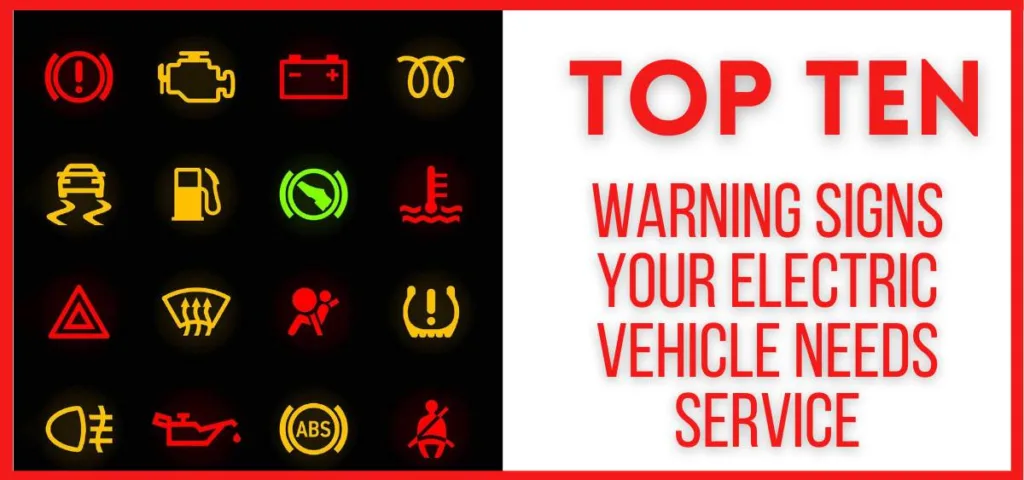Is your electric vehicle (EV) starting to act up? It’s important to pay attention to any unusual signs, as they could indicate that your EV needs service. Ignoring these warning signs could lead to more significant problems down the line. So, what are some of the top 10 indicators that your electric vehicle needs service? Keep an eye out for unusual noises, reduced range, slow charging times, battery warning lights, problems with the charging port, unusual smells, decreased performance, issues with the climate control system, and any strange vibrations. If you notice any of these symptoms, don’t delay in seeking professional help. A timely service can prevent more costly repairs and ensure that your EV continues to perform at its best.
Also, read: Top 10 Tips for Extending Your Electric Vehicle’s Battery Life
Some Safety Tips
- Make sure your car is equipped with all the necessary safety features and that they are working correctly.
- Always wear a seatbelt and make sure all passengers do too, even when just traveling short distances.
- Find specialized help with our list of electric charging station installation contractors.
- Always obey the speed limit and stay within the speed limit in residential areas.
- Be mindful of other road users and be aware at all times of potential hazards.
- Always check the backseat before leaving the car to make sure no one has been left behind.
- In the event of an emergency, always call the appropriate emergency services immediately.
EV Check-Up: Top 10 Warning Signs Your Electric Vehicle Needs Service
Electric vehicles (EVs) are becoming increasingly popular, but just like gasoline-powered cars, they require regular maintenance and service to keep them running smoothly and safely. Here are 10 warning signs that your EV might need a checkup:

1. Warning lights on the dashboard
Don’t ignore the colorful symphony of lights on your electric vehicle’s dashboard! They’re your EV’s way of crying for help. Red lights like a fiery battery or an electrical fault symbol demand immediate attention; pull over and seek professional help. Amber lights, like the familiar low battery or tire pressure warning, mean you can cautiously drive to a service station or schedule an appointment. Remember, a little TLC goes a long way toward keeping your electric journey smooth!
2. Decreased range
In the realm of electric vehicles, encountering a notable decrease in range can be a cause for concern and warrant immediate attention. The phenomenon of decreased range often signifies potential issues with the vehicle’s battery or overall efficiency. As electric vehicles rely heavily on the health of their battery systems, a reduction in range may indicate battery degradation, a critical aspect affecting performance.
Factors such as extreme temperatures, charging patterns, and the age of the battery can contribute to this decline. Addressing this warning sign promptly is crucial to ensuring optimal functionality and preventing more severe complications. Regular maintenance and monitoring of charging habits can play a pivotal role in sustaining the longevity of the battery and, consequently, the overall health of the electric vehicle.
Also, read: Top 10 Myths About Electric Vehicle Maintenance Busted
3. Strange noises
Does your usually silent EV suddenly sound like a haunted house? Don’t panic! Strange noises can be unsettling, but they’re often clues to specific issues. Whining from the motor could indicate worn bearings while clunking from the suspension might mean loose components. Grinding brakes or a high-pitched squeal during charging deserve immediate attention from a qualified mechanic. Remember, early detection and repair can save you from bigger problems down the road, so listen closely to your EV’s unusual music and get it checked out for a harmonious driving experience!
4. Reduced performance
When it comes to the realm of electric vehicles, a noticeable dip in performance serves as a significant red flag, signaling potential issues that demand immediate attention. Reduced performance can manifest in various ways, from sluggish acceleration to a general decline in overall driving dynamics. This warning sign often points to underlying problems in crucial components like the electric motor, power electronics, or even the vehicle’s software systems.
It’s imperative not to overlook these performance nuances, as they can impact the safety and efficiency of the electric vehicle. Whether it’s a software glitch affecting responsiveness or a deeper mechanical issue hindering acceleration, addressing these performance concerns promptly is key to maintaining the optimal functionality of your electric vehicle. Regular check-ups, adherence to manufacturer guidelines, and swift action in the face of diminished performance are integral to ensuring a seamless and enjoyable driving experience in your electric vehicle.
Also, read: Top 10 Reasons to Buy Renault Megane
5. Unusual tire wear
Spotting uneven or premature tire wear on your EV isn’t just about aesthetics – it’s a potential sign of deeper trouble. Cupping (uneven wear on the center or edges of the tread), excessive feathering (tiny, wavy lines on the tire’s sides), or bald patches could point to misalignment issues, worn shocks or struts, or even problems with the suspension. Don’t ignore these rubbery red flags! Have your EV checked by a qualified mechanic to diagnose the cause and fix it before uneven wear throws your whole driving experience out of whack. Remember, keeping your tires in tip-top shape ensures optimal performance, safety, and longer tread life for your electric journey.
6. Excessive vibration
Excessive vibration in an electric vehicle is a warning sign that should not be underestimated, as it often indicates underlying issues that require immediate attention. In the realm of electric vehicles, a smooth and vibration-free ride is the norm. Any deviation from this can be attributed to problems in the tires, suspension, or even the alignment.
These vibrations not only compromise the comfort of the ride but may also point to potential safety hazards. Regularly inspecting the tires for wear and tear, checking the suspension components, and ensuring proper wheel alignment are essential steps to mitigate excessive vibrations. Ignoring these warning signs could lead to more severe issues, impacting not only the driving experience but also the overall performance and longevity of the electric vehicle. Addressing excessive vibration promptly ensures a safer and more enjoyable journey in your electric vehicle.
A whiff of burning plastic or electrical fire from your EV isn’t a cozy campfire aroma – it’s a blaring alarm! Stop driving immediately and call for help. This scorching sign could indicate overloaded wiring, a malfunctioning battery component, or even a rodent chewing on cables. The longer you wait, the greater the risk of serious damage or even fire. Remember, your EV’s safety, yours, and those around you take priority. Don’t hesitate to pull over and let the professionals handle the heat before your electric journey takes a fiery turn.
8. Difficulty charging
Encountering difficulty while charging your electric vehicle is a significant warning sign that demands attention for the overall health of your EV. Charging issues can manifest in various ways, from prolonged charging times to outright failures in the charging process. This warning sign often points to underlying problems with the vehicle’s charging system, battery, or even the charging infrastructure. It’s crucial not to dismiss these challenges lightly, as they can hinder the convenience and reliability of your electric vehicle.
Whether it’s a faulty charging cable, issues with the charging port, or problems with the battery, addressing difficulty charging promptly is essential. Regularly monitoring your charging equipment, ensuring compatibility with charging stations, and seeking professional assistance when issues arise are integral to maintaining the seamless functionality of your electric vehicle’s charging system.
Also, read: Ten Signs That Your Car’s Battery is Dying
9. Software glitches
Is your EV suddenly acting buggy? Unexpected screen messages, erratic charging behavior, or phantom alerts might not be ghosts in the machine but glitches in the software. While some minor hiccups can be resolved by a simple reboot, persistent or concerning issues need attention. Outdated software can affect battery performance, charging compatibility, and even safety features.
So, stay updated! Check for available software updates and download them to keep your EV’s brain functioning optimally. And if glitches persist or seem serious, don’t hesitate to visit a qualified service center for a software checkup. Remember, a healthy dose of digital TLC can keep your electric journey smooth and glitch-free!
10. Reduced regenerative braking
If you notice that your EV isn’t regenerating as much energy when you brake, it could be a sign of problems with the battery or the regenerative braking system. If you notice any of these warning signs, it’s important to take your EV to a qualified mechanic as soon as possible. Early detection and repair can help prevent more serious problems and keep your EV running smoothly for years to come.
Your EV’s usually strong deceleration suddenly feels sluggish? Don’t underestimate the power of a powerful stop! Reduced regenerative braking, signaled by a weaker pull when you let off the gas, could point to issues with the battery, the regenerative braking system itself, or even software glitches. While you can still drive, your range might suffer and braking efficiency will be lower. Don’t wait for a complete energy loss – schedule a service appointment to diagnose the cause and restore your EV’s electric grip on the road!
Also, read: Top 10 Ways To Extend Your Car’s Battery Life
FAQs on Electric Vehicle Needs Service
Q. How much does it cost to charge an EV?
The cost of charging an EV depends on several factors, including the size of the battery, the electricity rate in your area, and the type of charger you use. In general, it’s much cheaper to charge an EV at home than it is to fill up a gas-powered car. On average, it costs around $4 to charge an EV at home, compared to $50 or more to fill up a gas tank.
Q. How far can an EV go on a single charge?
The range of an EV varies depending on the model, battery size, and driving conditions. However, most EVs have a range of between 200 and 300 miles on a single charge. Some newer models, like the Tesla Model S, can even go over 400 miles on a single charge.
Q. Are EVs safe?
Yes, EVs are just as safe as gasoline-powered cars. Some studies have shown that they may even be safer, as they are less likely to catch fire in a crash. Additionally, EVs produce zero emissions, which is better for the environment.
Q. How long does it take to charge an EV?
The charging time for an EV depends on the size of the battery and the type of charger you use. A Level 1 charger, which is the type of charger that comes standard with most EVs, can take up to 24 hours to fully charge a battery. A Level 2 charger can take anywhere from 4 to 8 hours to charge a battery. And a DC fast charger can charge an EV in as little as 30 minutes.
Q. Where can I charge my EV?
There are a growing number of places where you can charge your EV. You can charge at home using a Level 1 or Level 2 charger. You can also charge at public charging stations, which are becoming increasingly common in cities and along highways.
Q. Are there any government incentives for buying an EV?
Yes, there are several government incentives for buying an EV. These incentives can vary depending on the country or state you live in, but they can include tax credits, rebates, and exemptions from certain fees.
Q. What are the maintenance costs for an EV?
EVs have fewer moving parts than gasoline-powered cars, so they generally have lower maintenance costs. You won’t need to get oil changes or tune-ups, and the brakes on EVs last much longer than the brakes on gas-powered cars. However, you will need to replace the battery eventually, which can be expensive.
Q. Are EVs fun to drive?
Yes, many people find EVs to be more fun to drive than gasoline-powered cars. EVs have instant torque, which means they can accelerate very quickly. They are also much quieter than gas-powered cars, which can make for a more enjoyable driving experience.
Q. Are there any environmental benefits to driving an EV?
Yes, there are many environmental benefits to driving an EV. EVs produce zero emissions, which helps to improve air quality and reduce greenhouse gas emissions. Additionally, EVs use less energy than gasoline-powered cars, which helps to conserve natural resources.
Q. Will EVs eventually replace gasoline-powered cars?
It is too early to say for sure whether EVs will eventually replace gasoline-powered cars. However, the popularity of EVs is growing rapidly, and they will likely play a major role in the future of transportation.
Conclusion: The Final Words
Electric Vehicle Needs Service – It’s a phrase that no EV owner wants to hear, but it’s a reality that every EV owner will eventually face. Regular maintenance is crucial to ensure your electric vehicle performs at its best and lasts for years to come. By being aware of the top 10 warning signs listed in this blog, you can proactively address any issues before they escalate into more serious problems. Remember, Electric Vehicle Needs Service is not a negative phrase; it’s simply a reminder that your EV requires care and attention to maintain its optimal performance and longevity. So, keep an eye out for these warning signs and schedule regular maintenance appointments to ensure your electric vehicle continues to be a reliable and enjoyable mode of transportation.


































